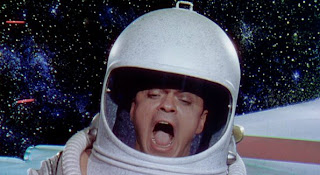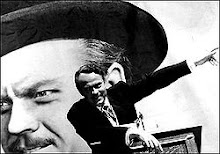“There's nothing wrong with Ellen. It's just that she loves too much.”
 This is one of my favorite films from the 1940’s; made in sumptuous oversaturated three-strip Technicolor (Oscar for Cinematography) and a major film for 20th Century Fox. Far From Heaven opened on Christmas Day and Darryl F. Zanuck personally supervised the production. He paid a record price for the best selling novel. And for the lead, he chose a star he named, “the most beautiful woman in the movie industry", Gene Tierney. For Leave Her To Heaven she won her first and only Oscar nomination (Best Actress); she lost to Joan Crawford in her comeback role as Mildred Pierce.
This is one of my favorite films from the 1940’s; made in sumptuous oversaturated three-strip Technicolor (Oscar for Cinematography) and a major film for 20th Century Fox. Far From Heaven opened on Christmas Day and Darryl F. Zanuck personally supervised the production. He paid a record price for the best selling novel. And for the lead, he chose a star he named, “the most beautiful woman in the movie industry", Gene Tierney. For Leave Her To Heaven she won her first and only Oscar nomination (Best Actress); she lost to Joan Crawford in her comeback role as Mildred Pierce. As good as Gene Tierney had been in Otto Preminger’s Laura and continued to be until her last major staring role when she was teamed with Bogart in 1955’s The Left Hand of God (why is this not on DVD?), this was her best performance. I also have a fondness for her role in Tobacco Road.
Cornel Wilde serves as a strand-in for a movie star. No one is hurt or helped by his performance. I would have expected something more nuanced after his earlier release A Song to Remember – that earned a Best Actor nod. But we won’t concern ourselves with Wilde or his performance.
The film’s director, John Stahl is mostly known for making “women’s” pictures (like the original Back Street 1932, Imitation of Life 1934 and Magnificent Obsession 1935). But this is no “women’s picture” of 1945. And it’s not really Stahl’s either. Zanuck deserves much of the credit for the storytelling and getting the whole thing past the Breen Commission to secure a MPAA seal of approval.
Leave Her To Heaven belongs to Gene Tierney and the film’s cinematographer Leon Shamroy.
What makes Leave Her To Heaven fascinating (and problematic for many) is how difficult it is to classify. Like film noir a femme fatal drives the action. Foreshadowing is used throughout the narrative and the film employs the often-used “B-movie” conceit of essentially telling the entire story in an extended flashback. Conversely, the production is the stuff of gothic romance. Photographed in the luscious three-strip Technicolor process and in the style of ‘romantic realism’. That being better than reality; hence the over saturation of color; nearly all of the action takes place outdoors in broad daylight (often in and around water).
The story was unusual at the time. Rather than having a man obsessed with a woman, the story plays the other way around. Tierney’s character is a woman (with “father” issues), dangerously obsessed with her finance (later husband) played by Cornell Wilde. This was Tierney’s follow-up film to Laura from the previous year, where she played the object of Dana Andrews’s obsession. Here we see all of the characteristics of the femme fatal in broad daylight against the beautiful New Mexico desert and rural Maine in the summertime. Tierney as Ellen Berent Harland is cold as ice and as cunning as a trapped wild animal.
Leave Her To Heaven earned three other nominations: for art direction, sound and a win for Leon Shamroy’s cinematography. Shamroy was no stranger to the Academy having won twice before (The Black Swan 1942 and Wilson 1944). Leon enjoyed a lifetime total of 18 nominations in the category and four wins (last in 1964 for Cleopatra).
Shamroy’s use of three-strip Technicolor process gives the whole production a surreal and sensuous feel that rivals Powell & Pressburger’s Black Narcissus (Jack Cardiff won AA cinematography in 1948) as being one of the most innovative uses of the process for its day. Directors from Douglas Sirk to Martin Scorsese and Todd Haynes have talked about Shamroy’s influence of their work. The heavily saturated color illuminates the range of passions blazing beneath Gene Tierney’s character’s icy exterior.
The supporting cast features many of Fox’s best contract players of the day. They include Vincent Price giving his usual part of the day as the third wheel in romance. It’s interesting to note that he starred a year earlier with Tierney in Otto Preminger’s Laura playing a jilted lover as well. This was Price’s stock and trade before he made all of those he became the start of all those wonderful low-budget horror films for William Castle and Roger Coreman in the ‘50’s and ‘60’s. Ray Collins (of Orson Welles Mercury Theater Group) plays the family friend and attorney. Gene Lockhart plays the family doctor (it amazing that his sequence got by the Breen Commission). Jeanne Crain plays Tierney’s stepsister and Mary Philips plays her mother. And Chill Wills basically plays himself.
But Darryl Hickman, as the vulnerable younger brother of Wilde, is the one you’ll remember. What happens to him plays out as one of the most terrifying scenes ever filmed in the movies. Hickman provides considerable insight into the film and working with Tierney in the commentary track (little is spared).
The film’s tagline, “Hers was the deadliest of the seven sins” couldn’t be more accurate.
Leave Her To Heaven was met with decidedly mixed reviews. Bosley Crowther at the New York Times wrote, “Miss Tierney's petulant performance of this vixenish character is about as analytical as a piece of pin-up poster art.” But the people crowed the theaters and it became the highest grossing film of the year and decade for Twentieth Century Fox. Zanuck knew how to make crowd pleasers.
The DVD (with it’s restored print) is a great way to spend a Sunday afternoon.






























